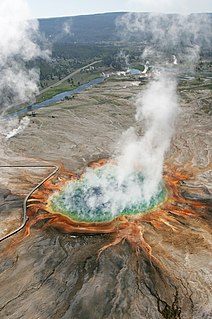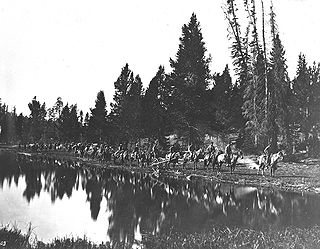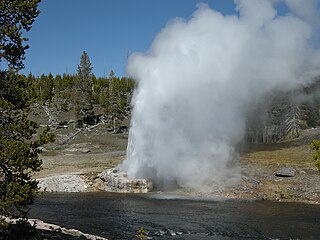
Riverside Geyser is a geyser in Yellowstone National Park in the U.S. state of Wyoming.
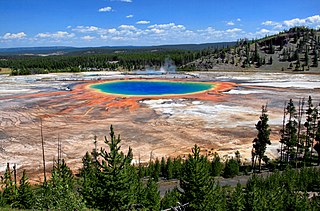
The Grand Prismatic Spring in Yellowstone National Park is the largest hot spring in the United States, and the third largest in the world, after Frying Pan Lake in New Zealand and Boiling Lake in Dominica. It is located in the Midway Geyser Basin.
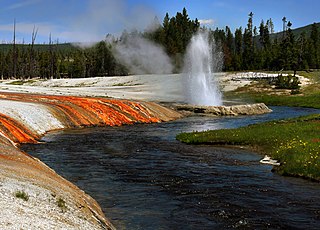
The Firehole River is located in northwestern Wyoming, and is one of the two major tributaries of the Madison River. It flows north approximately 21 miles (34 km) from its source in Madison Lake on the Continental Divide to join the Gibbon River at Madison Junction in Yellowstone National Park. It is part of the Missouri River system.

Comet Geyser is a geyser in the Upper Geyser Basin of Yellowstone National Park in the United States.

A-0 Geyser is a geyser in the Lower Geyser Basin of Yellowstone National Park in the United States.
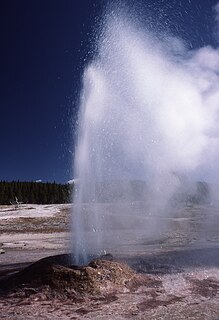
Pink Cone Geyser is a cone-type geyser in the Lower Geyser Basin of Yellowstone National Park in the United States. It is part of the Pink Cone Group. Other geysers in this groups include Bead Geyser, Box Spring, Dilemma Geyser, Labial Geyser, Labial's Satellite Geyser, Narcissus Geyser, and Pink Geyser.
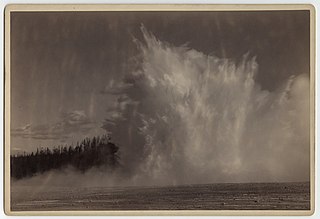
Excelsior Geyser Crater, formerly known as Excelsior Geyser, is a dormant fountain-type geyser in the Midway Geyser Basin of Yellowstone National Park in the United States. Excelsior was named by the Hayden Geological Survey of 1871.
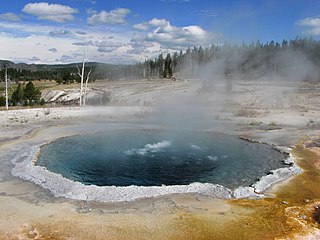
Crested Pool is a hot spring in the Upper Geyser Basin in Yellowstone National Park. The spring is 42 feet deep. It is named for the "crest" which surrounds the pool. Although it is considered a spring, Crested Pool sometimes erupts like a geyser.

Sulphur Spring, is a geyser in the Hayden Valley region of Yellowstone National Park in the United States. Sulphur spring has a vent Temperature of 89 °C (192 °F) although the actual temperature of the spring is 79.8 °C (175.6 °F). It is located in the Crater Hills area of Hayden Valley about 1 mile (1.6 km) west of the Grand Loop Road.

The following articles relate to the history, geography, geology, flora, fauna, structures and recreation in Yellowstone National Park.
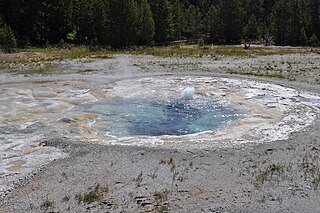
Spasmodic Geyser is a geyser located in the Upper Geyser Basin in Yellowstone National Park in the United States.

Doublet Pool is a hot spring in the Upper Geyser Basin of Yellowstone National Park, Wyoming.

Lone Star Geyser is a cone type geyser located in the Lone Star Geyser Basin of Yellowstone National Park. The basin is a backcountry geyser basin located 3 miles (4.8 km) southeast of Old Faithful Geyser and the Upper Geyser Basin. The geyser is reached via an old service road open to hikers and biking with the trailhead near Kepler Cascades on the Grand Loop Road.

Jewel Geyser is a fountain geyser in the Upper Geyser Basin of Yellowstone National Park in the United States. It is in the Biscuit Basin complex that includes Black Diamond Pool, Black Opal Spring, Wall Pool, Sapphire Pool, Shell Spring, Silver Globe Spring, Avoca Spring, West Geyser, the Mustard Springs, Coral Geyser, and Black Pearl Geyser.

Sawmill Geyser, named for the whirring sound it makes during its eruption, is a geyser in Yellowstone National Park, Wyoming, United States. The geyser was named by Antoine Schoenborn of the Hayden Geological Survey of 1871.

Opal Pool is a hot spring in the Midway Geyser Basin of Yellowstone National Park, Wyoming. Opal Pool usually has a temperature of approximately 132 °F (56 °C). Though usually active as a hot spring, Opal Pool is considered a fountain-type geyser.
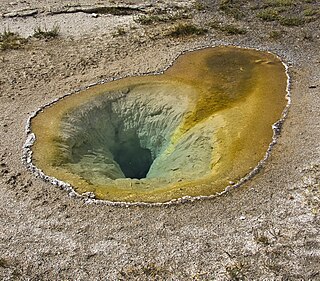
Belgian Pool is a hot spring in the Upper Geyser Basin of Yellowstone National Park, Wyoming. Marginally named Oyster Spring, it was renamed after a visitor from Belgium fell into it in 1929 with fatal results. The spring is less hot than other features in the area, at about 180 °F (82 °C), but still sufficiently hot for severe thermal burns. References to a "Belgian Geyser" in the 1930s may refer to this feature.
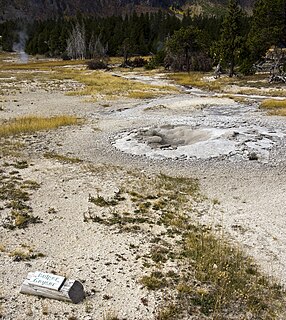
Bulger Geyser is located in the Upper Geyser Basin of Yellowstone National Park, Wyoming. Bulger Geyser is 200 feet (61 m) south of Grand Geyser. It erupts frequently, with both major and minor eruptions. As with most geysers, the minor eruptions are the most common. They have a duration of seconds. Major eruptions are infrequent, but they have durations as long as 12 minutes. Either way, the play consists of somewhat vigorous bursting 1–12 feet high.
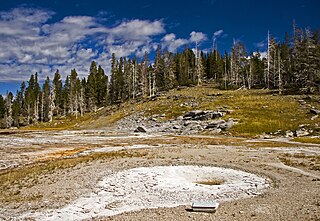
West Triplet Geyser is a geyser in the Upper Geyser Basin of Yellowstone National Park, Wyoming. West Triplet Geyser is 85 feet (26 m) south of Grand Geyser. Its activity is related to that of Grand and Rift geysers. West Triplet erupts to a height of about 10 feet (3.0 m), usually during Grand's quiet periods. Before 1947 it displayed regular activity, erupting about every three hours.
